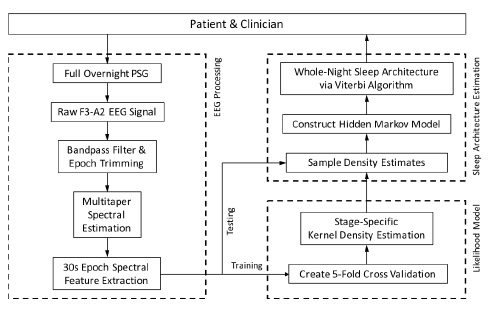- ALL COMPUTER, ELECTRONICS AND MECHANICAL COURSES AVAILABLE…. PROJECT GUIDANCE SINCE 2004. FOR FURTHER DETAILS CALL 9443117328


Projects > ELECTRONICS > 2017 > IEEE > DIGITAL SIGNAL PROCESSING
Although the importance of sleep is increasingly recognized, the lack of robust and efficient algorithms hinders scalable sleep assessment in healthy persons and those with sleep disorders. Polysomnography (PSG) and visual/manual scoring remain the gold standard in sleep evaluation, but more efficient/automated systems are needed. Most previous works have demonstrated algorithms in high agreement with the gold standard in healthy/normal (HN) individuals – not those with sleep disorders. Methods: This paper presents a statistical framework that automatically estimates whole-night sleep architecture in patients with obstructive sleep apnea (OSA)–the most common sleep disorder. Single-channel frontal electroencephalography was extracted from 65 HN/OSA sleep studies, and decomposed into 11 spectral features in 60,903 30s sleep epochs. The algorithm leveraged kernel density estimation to generate stage-specific likelihoods, and a 5-state hidden Markov model to estimate pernight sleep architecture.
Time–Frequency Analysis, Multiscale Entropy and Autoregressive Models.
New technologies have the potential to disrupt the clinic, and the field of sleep medicine may be able to move beyond the limitations of the “gold standard†PSG through smaller and more efficient devices for recording and generating clinical sleep metrics. While the recent surge of minimalistic, at-home sleep monitoring devices aims to improve sleep medicine practices, these endeavors lack analytic techniques that efficiently estimate sleep architecture from reduced data streams. This work outlines a statistical framework for classifying whole-night sleep architecture from single-channel EEG spectral features. The algorithm formulated sleep architecture and the five clinical stages of sleep as a transition constrained, state space process with intra-stage multimodality in the domain of EEG spectra. Results of the study show the algorithm is able to utilize single-channel EEG to automatically discriminate and score whole-night sleep architecture in both HN and OSA sleep, in many cases with high Cohen’s kappa agreement, when compared to clinical scoring from experts using full PSG. Moreover, the algorithmic approach sustains fair scoring agreement for increased OSA severity, demonstrating potential for generalizability and objectivity in the evaluation of the many intricacies of sleep and sleep disorders. This is one of just a few studies that have implemented state space modeling for single-channel sleep scoring, and the first known study to implement such statistical methods for automated sleep architecture performance in OSA subjects. The continued development of such low-resource algorithms – guided by clinical expertise and emphasizing clinical practicality – will help realize automated tools for assessing sleep and sleep disorders in inpatient and outpatient populations.
BLOCK DIAGRAM
